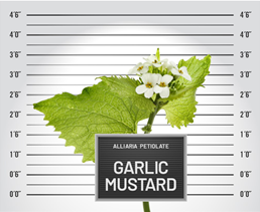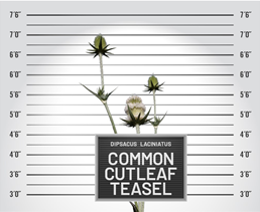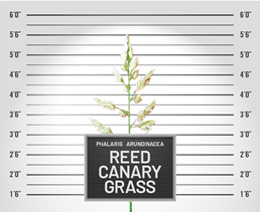Humans have traded plant roots, fruits, and seeds for centuries. Through this process, many plants have been moved out of their native ecosystems and replanted into areas where they previously did not exist. Today we not only find non-native plants growing in our urban gardens but also in our natural areas. It appears these plants have escaped from our cultivated gardens, but how could this happen?
For these plants to escape, they need a little help. Plants with profuse blooms usually produce excessive amounts of fruit, which is then eaten by wildlife and dispersed in our natural areas. The seed-dispersing process is common even with our native plants.
Here are a few invasive plants sneaking in this spring. We encourage you to learn more about these pesky perpetrators and keep an eye out for them.
 Alliaria petiolata (garlic mustard) is an herbaceous invasive plant commonly seen in woodland settings in the spring of the year before the native trees leaf out. While it was originally found in the undergrowth of disturbed woodlots and forest edges, garlic mustard has recently been spotted in more areas. Identifying first-year plants can be difficult, but the garlic smell produced when the leaves are crushed is a giveaway. Dark green, kidney-shaped leaves appear in the first year that become hairy as the plant matures. Garlic mustard flowers arrive in early April and have four small white symmetrical petals. Mature garlic mustard can grow up to 3.5 feet tall.
Alliaria petiolata (garlic mustard) is an herbaceous invasive plant commonly seen in woodland settings in the spring of the year before the native trees leaf out. While it was originally found in the undergrowth of disturbed woodlots and forest edges, garlic mustard has recently been spotted in more areas. Identifying first-year plants can be difficult, but the garlic smell produced when the leaves are crushed is a giveaway. Dark green, kidney-shaped leaves appear in the first year that become hairy as the plant matures. Garlic mustard flowers arrive in early April and have four small white symmetrical petals. Mature garlic mustard can grow up to 3.5 feet tall. Dipsacus laciniatus (common cutleaf teasel), is an herbaceous, biennial plant native to Europe and colder Asian climates you may notice along highways and meadows that are not cared for. Teasel plants grow as a rosette the first year and then bolt to produce a single flower stock that can reach up to 5 feet tall in the second year of their life cycle. This tall flower stock is what you may notice in the spring. The spent flowers give the plant a unique look; it is frequently used in dried flower arrangements. It is a prolific seed producer which gives it an edge over native vegetation. It is best to control this species in the spring while it is in the rosette stage.
Dipsacus laciniatus (common cutleaf teasel), is an herbaceous, biennial plant native to Europe and colder Asian climates you may notice along highways and meadows that are not cared for. Teasel plants grow as a rosette the first year and then bolt to produce a single flower stock that can reach up to 5 feet tall in the second year of their life cycle. This tall flower stock is what you may notice in the spring. The spent flowers give the plant a unique look; it is frequently used in dried flower arrangements. It is a prolific seed producer which gives it an edge over native vegetation. It is best to control this species in the spring while it is in the rosette stage. Phalaris arundinacea (reed canary grass) is an herbaceous, rhizomatous, perennial, grass plant found throughout the Great Lakes region. This plant prefers to grow in wetland plant communities like wet meadows, wet prairies, riparian areas, bogs, and fens. It can be found growing in the temperate regions on five continents including North America. Researchers have debated as to whether it is native to North America. One thing for sure, because of its aggressive root system, if it becomes established in an ecologically sensitive wetland it will soon be the dominant species there. Look for this invasive grass plant along ditches, coastlines, and wetlands. In the spring it can be identified as a thick brown patch of tall biomass. These monotypic stands can be a fire hazard. Control the spread of this plant with mowing and herbicide regimens in the spring before it produced seed.
Phalaris arundinacea (reed canary grass) is an herbaceous, rhizomatous, perennial, grass plant found throughout the Great Lakes region. This plant prefers to grow in wetland plant communities like wet meadows, wet prairies, riparian areas, bogs, and fens. It can be found growing in the temperate regions on five continents including North America. Researchers have debated as to whether it is native to North America. One thing for sure, because of its aggressive root system, if it becomes established in an ecologically sensitive wetland it will soon be the dominant species there. Look for this invasive grass plant along ditches, coastlines, and wetlands. In the spring it can be identified as a thick brown patch of tall biomass. These monotypic stands can be a fire hazard. Control the spread of this plant with mowing and herbicide regimens in the spring before it produced seed.
Many of the traits that make a plant an outstanding ornamental plant also make it an outstanding candidate to become invasive. We value ornamental plants for their lush displays of flowers and fruit, as well as their hardiness and ability to easily grow. These traits give non-native plants an ecological advantage over our native plants when found growing in our natural areas.
Davey Resource Group, Inc. (DRG) biologists are trained to recognize these and our native plants in natural settings. Our staff are also experts in eradicating invasive vegetation and restoring your native areas back to their native plant communities.



